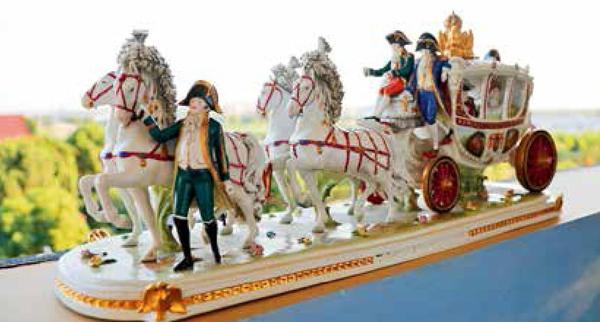企业家陈坚与古董八音盒
张银燕?刘琨



提起溫州人陈坚,别人对他的印象是:20世纪90年代,前往葡萄牙建立两座“中国城”;2009年回国后,在嘉兴平湖打造亚洲最大的进口商品城。
最近,“贪玩”的陈坚又换了新标签:收藏几十万件来自世界各地的古董,走出一条前所未有的文化产业之路。
2020年8月13日,我赶到嘉兴平湖,在陈坚的带领下,穿梭在风格新奇的古董博物馆内,与“百岁以上高龄”的八音盒、钢琴、放映机等进行深度“对话”。
一
陈坚的平湖国际进口商品城,集进口商品超市、欧洲小镇、展销中心、智能住宅、葡萄酒博物馆等于一体,被很多人昵称为国际游购小镇。
来到这个别具异域风情的小镇,已是下午2点。徜徉在小镇内,偶有马车载着游客经过,哒哒的马蹄声,恍若进入上世纪的欧洲。
我到的第一站,是陈坚创办的“沉浸式”展馆19世纪德国家居博物馆。
走过花园,走进客厅,坐在有100多年历史的沙发上,听着机械琴的演奏,仿佛置身于19世纪欧洲的一个大房子里。餐厅、卧室、厨房、书房,无不透露着当时德国的文化和艺术气息。“这里有4000多件藏品,几乎都来自德国。”陈坚笑着介绍。
在19世纪德国家庭风格的书房内,他讲述了自己的人生故事。
陈坚出生于1963年,祖籍瑞安丽岙。出国时,陈坚已经29岁了,此前他在银行工作。身处侨乡,耳闻目睹的多是外面的世界。那一年他辞职赴海外创业,先是到澳大利亚,后又辗转匈牙利、荷兰,最后落脚葡萄牙。在葡萄牙,他将服装、钟表、电器、工艺品等中国产品销往南欧,生意越做越大。
2009年,陈坚看到国内的发展,决定回国。会折腾的人,内心必然有一股力争上游的信念。陈坚原本计划打造一个国际葡萄酒博览交易城,结果考察了几年,他发现国内已经有不少人在做了这个业务了。
于是陈坚推倒重来,决心打造一个国际进口商品城。进口商品城2013年动工,如今已经初具规模。“德国小镇”造好了,进口商品城、服装城开始营业,古董博物馆开馆,吸引大批上海、杭州和嘉兴的市民前来打卡。
二
什么时候开始走上收藏之路的?
陈坚说,在1998年葡萄牙里斯本世博会上,他购买了当时中国馆的大部分物件,然后就喜欢上了收藏。20年来,为了收藏各个时期的宝贝,他的足迹遍布世界各地。对他而言,这件事情不仅有趣,更有意义。
“走,带大家看看我最得意的宝贝。”他说。
在小镇里边走边看,很快就来到陈坚的办公室,里面堆满了各种各样来自不同国家和地区的商品,像是到了“万国博览会”的现场。
办公室隔壁有个不大的展示厅,摆件不多,凭我的辨识能力,猜出其中有巨大的八音盒,古老的自动钢琴。让我纳闷的是一个大柜子,虽然古橡木彰显出它的年代感,可乍一看就是一件老家具。
陈坚来到柜子前,郑重地介绍:“这件宝贝是能演奏交响乐的机械。”然后,他打开柜门,哇,里面竟然藏着多种乐器。
当陈坚拨动开关,恢宏的音乐响起,我不禁为之震撼。“它来自德国,有一百多年历史了。”陈坚解释说,在1880年至1900年间,德国有着高深音乐素养的能工巧匠们制作了一批批组合式交响乐器,后来,因为黑胶唱片机的诞生,这些机器被淘汰。
一次偶然的机会,陈坚寻觅到几百件产自那20年间的机械乐器,就全部买了过来。“有不少是世间难得的藏品,目前正在整理中,我们会布置一个音乐博物馆。”
参观完展示厅,又来到钢琴博物馆、近代工业文明博物馆,1826年的三角钢琴、第一代苹果电脑、第一代放映机……它们琳琅满目,静静地躺在那里,述说着岁月流转的故事。
三
收藏的路上陈坚时常在思考:自己的初衷是什么。
“除了能让老百姓足不出户看遍世界各地的文化,还能看到100年前的我们与世界的差距。”陈坚说,改革开放已经拉近了中国与世界的距离,希望不久的将来,通过所有中国人的努力,让大家看到中国为世界发展和人类进步所作出的新的贡献。
目前,陈坚收藏的古董能系统地做近20个博物馆,要是缺哪个时代、不同历史的东西,他会继续搜集、补齐以形成系列。采访中,我时刻感受到他是如何小心翼翼地呵护每一件古董,如数家珍地讲述其背后的故事。在他看来,收藏是一门很深的学问,他需要不断地去学习、探索,以拓宽知识面。而收藏最重要的,是要有坚韧不屈的耐性和吃苦耐劳的精神。
欧洲各国的古董市场,也是陈坚经常流连的地方,好东西要淘,眼尖、脚勤还要下手快,而他往往是第一批到达市场的人。2019年1月,为了在比利时座钟市场淘宝,凌晨3点,他和团队顶着零下20摄氏度的气温,把30多斤的座钟一件一件往车上搬。
出国多年,陈坚时刻眷恋着家乡,也希望能为家乡贡献力量。
收藏的几十万件宝贝中,他早已将最珍贵的藏品——1998年里斯本世界博览会中国馆镇馆之宝郑和下西洋骨雕珍品,捐赠给了世界温州人博物馆。这件珍品,也成为世界温州人博物馆的镇馆之宝。
不仅如此,他还有更宏伟的规划。
他希望世界各地的温籍侨胞可以联动,将各自收购的古董,集中到温州,共同打造一个世界级古董博物馆。
“这是一件很有意义的事情,只有温州人能做到。”陈坚信心满满地描绘道,“我们有68.8万温州人生活在世界各地,如果每个人都加入其中,必定会把温州打造成‘淘宝之城,全中国甚至全世界的古董爱好者都将慕名前来。”
Wenzhounese Chen Jian is known by many people as the founder of the two “China town” built in the 1990s in Portugal and the Imported Commodity Town in Pinghu, Jiaxing, crafted by the man after he returned to China in 2009.
Chens focus in recent years is on antiques. His collection of hundreds of thousands of curios and antiques from all over the world, displayed at the themed museums in the Import Commodity Town in Pinghu, highlights his dream of cultural innovation come true.
The visit to the Import Commodity Town, a must-see for tourists in Jiaxing, in the summer of 2020, was a time-traveling experience for me. The multi-functional town encompasses different zones including a wine museum. The first leg of my tour was the 19th Century German Home Museum, where visitors can enjoy an immersive tour of the cultural profundity of Germany. The house contains about 4,000 exhibits, mostly from Germany, presenting the fascinating arts and culture of the European nation.
Sitting in the German-style study of the house, Chen Jian shared his life story with me. Born in Liao in Ruian, Wenzhou, in 1963, Chen moved to Australia at the age of 29, and then spent years in Hungary and Holland before settling down in Portugal, where he built his own trade business by selling made-in-China commodities such as clothes, clocks and watches, electric appliance, and artware in Southern Europe.
With a success story in foreign lands, Chen returned to China in 2009, determined to build a wine trade town. After several years of field studies, he decided to sow the seeds of an import commodity platform in Pinghu. The construction started in 2013. The first stage of the project has turned out quite successful, drawing visitors from other parts of Jiaxing as well as people from Shanghai and Hangzhou.
Chens passion in curios and antiques began in 1998, when he was in Portugal for the Lisbon World Expo. He brought home almost everything from the China Pavilion at the expo. For the past two decades, he traveled the whole world to build up his collection, and turned a hobby into his new career.
In Chens office in the town, antiques are piled up to the ceiling. The adjoining exhibition space is a musical world. A huge cabinet-looking thing caught my eye.
“This is an orchestral device,” Chen Jian introduced proudly and opened the “music box” to show me how it works. He turned it on, and a symphony-like music piece flowed out to fill up the room.
“It was made by musical artisans in Germany, and has a history of more than 100 years. This orchestral device was later replaced by vinyl record players, and became history.”
Chens music-themed collection now contains hundreds of musical instruments made in the period between 1880 and 1900.
“Many of them fall into the rarity category, and will be part of a music museum I am working on,” said Chen Jian.
Chen showed me around. His collection also includes a grand piano made in 1826, displayed in his Piano Museum. I saw a first-generation Macintosh Computer and a first-generation projector in his Modern Industrial Civilization Museum.
Behind the antiques he collected are many stories Chen would never get tired of sharing. To bring a tumbling-box music instrument home, for example, Chen had to go out of his way to make its owner believe that her family treasure would be in good hands. The persuasion took a lot of time and energy.
Chen diligently visits antique markets across Europe. He has to be sharper, faster, and more diligent than his rival antique collectors. In January of 2019, his team worked in freezing cold at a clock market at 3 in the morning in Belgium.
Over the years, Chen Jian has never stopped thinking. “I keep asking myself about what I really want. What I am striving to do is to make something for more people to see the cultural diversity of the world without having to leaving home. I also want to show the gap between China and the outside world a century ago, and how much the Chinese people have achieved over the past century to not only fill the gap but also contribute to the overall progress of the human world,” Chen explained, adding that he always wants to do something for his hometown.
Chen has donated a bone carving piece he bought from the 1998 Lisbon World Expo to World Wenzhounese Museum. “I hope to see the Wenzhounese communities outside China contribute more to a world-class antique museum in Wenzhou. It is something only Wenzhounese can achieve, and it means a lot to me,” says the ambitious collector. Chens goal is to build up his collection to fill up 20 museums.

